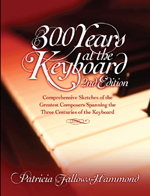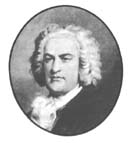Composer Example: Bach
We have produced a 312 page book that covers 17 of the greatest classical keyboard composers in history. For each composer we give a historical sketch of the composer, commentary on their style, commentary on their more important works and sample sheet music they have produced. We follow this with a comprehensive list of all their works so if you like what a composer is like you can instantly go order some or all of their sheet music.
In this discussion, we will give you a sample of the presentation we do for each composer.
Johann Sebastian Bach
Born in Eisenach, Germany
March 21,1685
Died in Leipzig, Germany
July 28, 1750,
Age 65 years
Historical Sketch
The achievements of Johann Sebastian Bach hold a place without parallel in music history. With the universality and vision of his genius, Bach fused the contributions of 16th, 17th, and early 18th Century composers in Italy, England, and France in terms of his own technique and style. With this synthesis, he created a musical mother tongue which has formed the basic language of western music to the present day.
Bach’s musical heritage was unique. His ancestors were outstanding performers and composers for 200 years before his birth, and in his youth the distinguished family numbered over 100 active musicians. Left virtually an orphan at 10, young Bach went to live with an older brother, Johann Christoph, in Ohrdruf. Johann Christoph, also a musician, arranged for Bach’s early education with a general curriculum. At 15, Bach moved to LÜneburg to begin formal musical training at St. Michael’s School. Here he studied singing, organ, violin, clavier, and composition. And here his first works, preludes and sets of variations, appeared. The organ became his favorite instrument, and organists famous for their style and technique soon exerted an influence on his maturing genius. The best known of these were Reincken in Hamburg and Buxtehude at Lubeck.
Bach left St. Michael’s School in 1703 for brief appointments in Arnstadt and MÜhlhausen. It was in Arnstadt that he wrote in 1704 the delightful
Capriccio on the Departure of a Beloved Brother. A few years later, in 1708, he secured his first important position as Court Organist and Musical Director at Weimar. Twenty-three at the time, he was already renowned as an organ virtuoso and master of improvisation.In 1717, Bach moved to CÖthen to become Director of Music for Prince Leopold in whose service he wrote largely for clavier, for orchestra, and for the combinations of instruments comprising chamber music. At CÖthen, he finished in 1722 the first book of the Forty-eight Preludes and Fugues for the Well-Tempered Clavier. This work was written as his acceptance of the system of tuning, or tempering, which made it possible to play in all twelve major and minor keys on any one clavier. Bach’s last position, in 1723.........
Style
If all the music in the world but Bach’s were destroyed, so the saying goes, the whole system of romantic and modern harmony could be re-established from it. Beethoven felt that Bach’s writing uncovered the roots of all music when he said, “Play a great deal of Bach and everything will become clear to you.”
Bach’s many-sided nature included discipline, drama, and poetry: as disciplinarian, he required clarity; as dramatist, he understood bravura and the emotional impact of climax building; as poet, he wrote with lyricism which went beyond personal expressiveness and suggested a universal source.
Universality may explain the ease with which Bach’s music is transcribed; Bach concerned himself with the idea rather than the instrumentation of it. Organ works can be exchanged with clavier or piano, and stringed works given to the keyboard.
Ideas for the limited range and resources of the harpsichord and clavichord expand naturally to the versatility of the modern piano. With Bach, melody was an outgrowth of counterpoint as well as a statement of its own individuality. His melodies, especially in the free forms, were expressive and singable, and even in contrapuntal context were warm and flexible. Except in the slow movements, rhythm in general was devoid of complications and advanced steadily to the climax with the same pattern often repeated throughout the work. Foreshadowing contemporary harmonies, modulations involved remote and unexpected keys.
Although Bach was at heart an innovator, Compositions Bach’s works are divided into three periods: Weimar (1708-17) when he wrote largely for organ; Cöthen (1717-23) when he composed many works for clavier; and Leipzig (1723-50) when he produced the choral masterpieces. The divisions are a matter of convenience for general reference. The keyboard works listed below appeared before, during, and after the fertile Cothen period.
Capriccio on the Departure of a Beloved Brother (1704) BWV 992
At the beginning of Bach’s residence in Arnstadt he wrote a rare example of program music inspired by his brother Jacob’s departure for Poland. It is a charming picture of leave-taking, depicting “the dangers of foreign lands” and the pleading of friends “to remain with us.” The second movement........
Lots more…….More about the publication, including reviews by major magazines and sample pages from the book can be found by clicking here:
![]()




